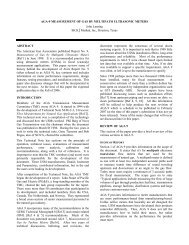FUNDAMENTALS OF ORIFICE METERING
FUNDAMENTALS OF ORIFICE METERING
FUNDAMENTALS OF ORIFICE METERING
Create successful ePaper yourself
Turn your PDF publications into a flip-book with our unique Google optimized e-Paper software.
Vena Contracta taps@-taps located 1 pipe diameter<br />
upstream of the orifice plate and at the vena contracts<br />
on the downstream side of the orifice plate. Not<br />
recommended when a variety of orifice bore sizes are<br />
required to meet flow requirements.<br />
Radius tap&-taps located 1 pipe diameter upstream of the<br />
orifice plate and 1/2 pipe diameter downstream of the orifice<br />
plate.<br />
(See figure 2 for the different tap locations)<br />
Figure 2<br />
FLOW RATE COMPUTATION<br />
The fundamental flow equation is<br />
Oh= C' hw Pf<br />
where:<br />
Oh = Flow rate at base conditions C' =<br />
Orifice flow coeff icient<br />
hw = Differential pressure<br />
Pf = Absolute static pressure<br />
The orifice flow coefficient is calculated using other<br />
constants that identify diameter of the pipe, orifice bore<br />
diameter, base pressure and temperature with variables that<br />
relate to the physical properties of the fluid such as<br />
temperature, specific gravity, density, viscosity, and<br />
compressibility. Any change in the diameter of the orifice<br />
bore fluid composition or temperature will change the<br />
coefficient, thus, changing the rate of flow.<br />
Through the invention of flow computers and extensive<br />
research in orifice measurement, new flow equations have<br />
recently been developed that offer minimal uncertainty in<br />
total flow computations. The new equations, in accordance<br />
with the Third Edition of AGA Report No. 3- Part 1, are<br />
extensive and are not addressed in this paper. Details of the<br />
new equations are available in advanced orifice metering<br />
publications.<br />
PRIMARY <strong>ORIFICE</strong> <strong>METERING</strong> EQUIPMENT<br />
Implementation of highly accurate secondary metering<br />
equipment (flow computers), the need for close<br />
tolerance primary equipment (meter tubes and orifice<br />
plates) is<br />
critical. AGA Report No. 3-Part 2 (API 14.3) provides<br />
recommended design considerations of orifice meter tubes.<br />
The following-is an overview of primary orifice metering<br />
equipment.<br />
Orifice Flange Unions<br />
The original orifice plate holding device was the orifice<br />
flange union (Figure 3). The orifice flange union was the<br />
only type orifice holder available until the invention of the<br />
orifice fifting, some 50+ years ago. Though inexpensive as<br />
compared to other devices, the orifice flange union utilizes<br />
the more expensive paddle plate and requires additional<br />
labor to perform an orifice plate change. The operator must<br />
loosen all bolts and remove half of the bolts, spread the<br />
flanges by use of jackscrews and remove the plate. Gaskets<br />
must be replaced in most cases.<br />
The orifice flange union is still used where periodical<br />
inspection is not required and the overall accuracy is usually<br />
less critical.<br />
<strong>ORIFICE</strong> FITTINGS<br />
Figure 3<br />
Frequent inspection of the orifice plate is often<br />
necessary to be certain the orifice plate is of quality<br />
condition to insure accuracy. In some installations,<br />
flow will vary to the extent that various sizes of<br />
orifices are required to keep the differential within<br />
range of ,the secondary device.<br />
Orifice fittings are designed to reduce the time and<br />
cost of inspection or changing of the orifice plate.<br />
Orifice fittings also offer precision machined critical<br />
dimensions and provide accurate centering of the bore<br />
in the center of the meter tube.<br />
For the purpose of inspection and calibration, the<br />
orifice fifting should include a flange connection,<br />
preferably on the downstream side. The use of<br />
weldneck orifice fittings is generally not recommended<br />
for minimum uncertainty since weldneck fittings in<br />
small sizes do not allow accessibility for<br />
measurements to be taken near the orifice plate.




